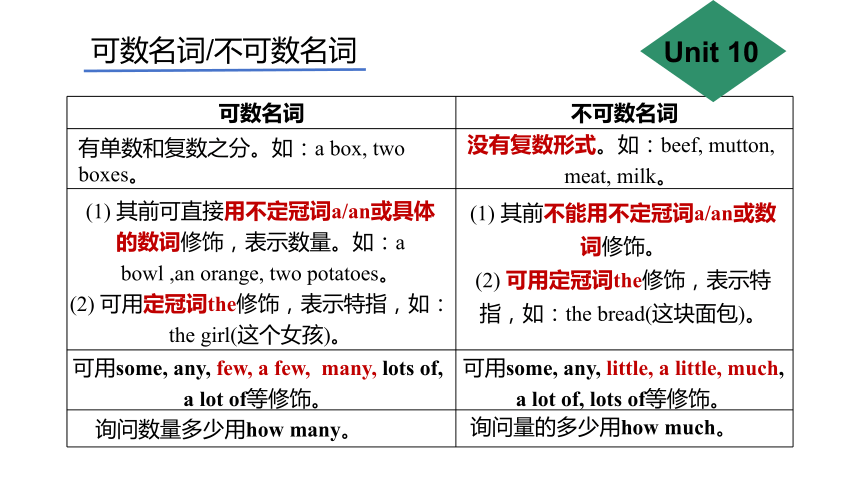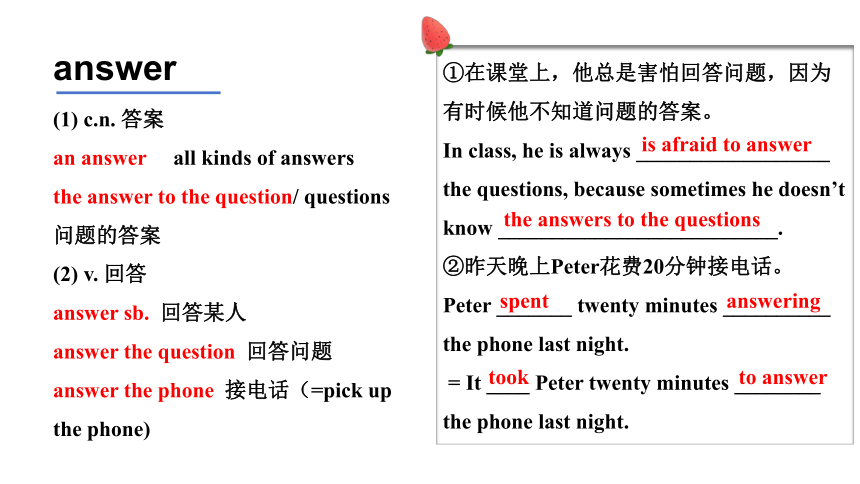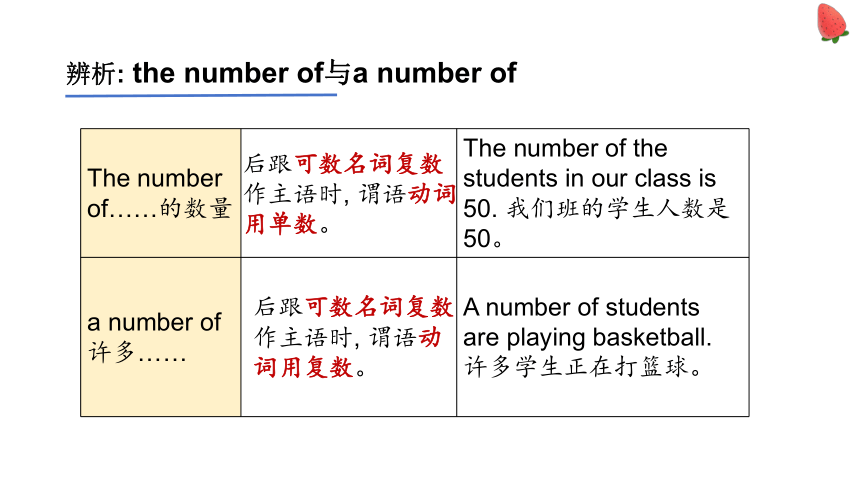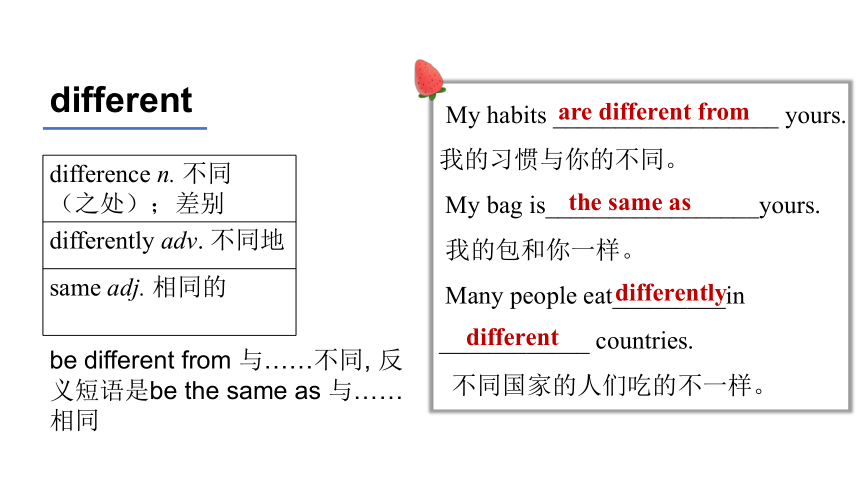人教新目标(Go for it)版七下期末复习课件unit 10-unit 12 考点复习课件(共47张PPT)
文档属性
| 名称 | 人教新目标(Go for it)版七下期末复习课件unit 10-unit 12 考点复习课件(共47张PPT) |  | |
| 格式 | pptx | ||
| 文件大小 | 49.4MB | ||
| 资源类型 | 教案 | ||
| 版本资源 | 人教新目标(Go for it)版 | ||
| 科目 | 英语 | ||
| 更新时间 | 2024-06-25 13:35:02 | ||
图片预览












文档简介
(共47张PPT)
人教版七年级下册复习课件
unit 10-unit 12 考点复习
可数名词 不可数名词
有单数和复数之分。如:a box, two boxes。
没有复数形式。如:beef, mutton, meat, milk。
(1) 其前可直接用不定冠词a/an或具体的数词修饰,表示数量。如:a bowl ,an orange, two potatoes。
(2) 可用定冠词the修饰,表示特指,如:the girl(这个女孩)。
(1) 其前不能用不定冠词a/an或数词修饰。
(2) 可用定冠词the修饰,表示特指,如:the bread(这块面包)。
可用some, any, few, a few, many, lots of, a lot of等修饰。
可用some, any, little, a little, much, a lot of, lots of等修饰。
询问数量多少用how many。
询问量的多少用how much。
可数名词/不可数名词
Unit 10
不可数名词的量可以用 “a/an/基数词+表示量的名词(bottle/grass等) + of + 不可数名词” 表示,这些表示量的名词有单复数形式的变化。这一结构作主语时,谓语动词的单复数形式要与表示量的名词保持一致。
There is a bottle of juice on the table. 桌子上有一瓶果汁。(谓语动词is与a bottle保持一致)
There are three bowls of mutton soup on the table. 桌子上有三碗羊肉汤。(谓语动词are与three bowls保持一致)
不可数名词量的表达
some和any 既可以修饰可数名词又可以修饰不可数名词。
some 常译作“一些”,多用于肯定句,也用在疑问句中,表示期望对方肯定的答复,以示礼貌; any表示“任何”,通常用于否定句和疑问句中。
some和any的用法
I can’t see _____ tea. 我没看见茶叶。 Do you have ____ friends at school
你在学校有一些朋友吗
Would you like________coffee
你要不要来点咖啡?
How about _________ fruit juice
来点水果汁如何?
Is there ______orange juice in the fridge
冰箱里有橙汁吗?
any
any
some
some
any
① 她喜欢吃鸡肉,所以她想要一些鸡肉。
She likes ___________chicken, so she _______ some chicken/ _______________ some chicken.
② Cindy想要去钓鱼。
_______________go fishing.
= ___________________go fishing.
would like
would like 想要,愿意
would是情态动词,没有人称和数的变化。
(1) would like sth. = want sth. 想要某物 (want有人称和数量变化)
(2) would like to do sth.= want to do sth.想做某事
to eat/ eating
wants
would like
Cindy wants to
Cindy would like to
③ 我的妈妈想要我努力学习。
My mother_______________study hard.
= My mother________________study hard.
would like
(3) would like sb to do sth = want sb to do sth 想要某人做某事
(4) --Would you like sth ( 就餐用语)
--肯:Yes, please./ 否:No, thanks.
(5) --Would you like to do sth (用来发出邀请)
肯:Yes, I’d like/love to.
否:I’d like/love to, but.../Sorry, I’ m afraid I can’t, because...
wants me to
would like me to
名词修饰名词
1)一般情况下,名词作定语,只能用单数。
2)man/woman修饰名词时,要和该名词的单复数形式一致 。
3) 当sport修饰名词时,都用复数形式,即sports。
an apple tree
five apple trees
carrot dumplings=dumplings with carrots
一位男老师 a man teacher
两位男老师 two men teachers
三位女音乐家 three women musicians
一个运动俱乐部 a sports club
两双运动鞋 two pairs of sports shoes
answer
(1) c.n. 答案
an answer all kinds of answers
the answer to the question/ questions 问题的答案
(2) v. 回答
answer sb. 回答某人
answer the question 回答问题
answer the phone 接电话(=pick up the phone)
①在课堂上,他总是害怕回答问题,因为有时候他不知道问题的答案。
In class, he is always __________________ the questions, because sometimes he doesn’t know __________________________.
②昨天晚上Peter花费20分钟接电话。
Peter _______ twenty minutes __________ the phone last night.
= It ____ Peter twenty minutes ________ the phone last night.
is afraid to answer
the answers to the questions
spent answering
took to answer
popular
popular (adj.)受欢迎的,流行的,普遍的
(1) be popular with sb.
受某人欢迎/喜爱
(2) get/ be popular
变得流行,变得受欢迎
① Mr. Smith教我们的英语,并且他很受
我们欢迎。
Mr. Smith _________________ English,
and he _________________.
② 这些天, 英语歌曲正变得流行。
The English songs are _________________these days.
teaches us
is popular with us
getting popular
辨析: the number of与a number of
The number of……的数量 The number of the students in our class is 50. 我们班的学生人数是50。
a number of 许多…… A number of students are playing basketball.
许多学生正在打篮球。
后跟可数名词复数作主语时, 谓语动词用单数。
后跟可数名词复数作主语时, 谓语动词用复数。
cut up
意为“切碎”,这是一个动词加副词组成的短语。名词作宾语,放在中间或后面均可。代词作宾语,放在两词之间。
blow out 也是同等用法。
—Why do you cut the apple up(cut up the apple)
你为什么把苹果切碎了
—I cut it up because I want to make apple salad.
我切碎它是因为我想做苹果沙拉。
different
difference n. 不同
(之处);差别
differently adv. 不同地
same adj. 相同的
be different from 与……不同, 反义短语是be the same as 与……相同
My habits __________________ yours. 我的习惯与你的不同。
My bag is_________________yours.
我的包和你一样。
Many people eat_________in
____________ countries.
不同国家的人们吃的不一样。
are different from
the same as
differently
different
or
and与or表示“和”的用法,肯定句中用and,否定句中用or。
or可用于肯定句和疑问句中,表示或者。
I like chicken ______ beef.
I don’t like chicken _____ beef.
我不喜欢鸡肉和牛肉。
I can join the chess club ___ the music club.
我可以参加象棋俱乐部或者音乐俱乐部。
Is he tall ______short
and
or
or
or
本句是 一个含有if引 导的条件状语从句的主从复合句。if 在此处作连词,意为“如果”。主句用一般将来时,if引导的条件状语从句用一般现在时表示将来。
If we get to school early tomorrow, our teacher will be happy.
如果我们明天早点儿到达学校,老师会很高兴。
【句式剖析】If he or she blows out all the candles in one go, the wish will come true.
if引导的条件状语从句
主句
if
feed /fi d/ v. 喂养; 饲养
feed 用作及物动词, 其后常接表示动物的名词作宾语。feed 的过去式为 fed。
e. g. My grandma feeds chickens every day.
我奶奶每天都喂鸡。
feed...to... 把……喂给……
feed...on... 用……喂养……
feed on... (动物)以……为食
考点1
Unit 11
考点2
quite a lot 许多, 在句中修饰动词。
e. g. He drank quite a lot. 他喝了好多。
辨析: quite 与very
“非常” 不同 quite 程度副词, 意为“相当; 非常”, 可修饰副词、形容词、动词。“quite+a/an+ 形容词+ 名词”。
very 程度副词, 意为“很, 非常”, 语气比quite重。可修饰副词、形容词, 不可直接修饰动词。“a+very+形容词+ 名词”。
e. g. It’s quite/very necessary to stop school bullying.
阻止校园欺凌非常有必要。
My brother thinks Li Lei sings quite/very well.
我哥哥认为李雷唱得非常好。
She quite likes swimming. 她非常喜欢游泳。
Tom is a very good boy.
=Tom is quite a good boy.
汤姆是个很好的男孩。
副词修饰形容词
副词修饰副词
副词修饰动词
anything/ en θ / pron. (常用于否定句或疑问句) 任何东西; 任何事物,形容词修饰不定代词后置。做主语时谓语单数。
在肯定句和希望得到对方肯定答复的疑问句中用something。
e. g. Is there anything important
有任何重要的事情吗
Would you like something sweet
你想吃甜的吗?
考点3
考题: —Helen, did you do ______ last weekend
—Yes, I visited my grandparents in the countryside.
A. anything special B. something special
C. special anything D.special something
A
【解析】用语法分析法解题。something 用于肯定句或表示请求、建议或征求意见的疑问句中; anything 用于疑问句或否定句中。本题问句是一般疑问句, 不表示请求、建议或征求意见。修饰不定代词的形容词要位于不定代词之后。
考点4
fun 作不可数名词, 意为“乐趣; 快乐”, 其前常用great, much, a lot of等修饰, 用来加强语气。作形容词表示有趣的。
e.g. Skating is great fun. 滑冰非常有趣。
The show is very fun. 表演很有趣。
have fun (in) doing sth.
=have a great time doing sth.
意为“很开心/ 高兴/愉快地做某事”。
考点5
luckily /l k li/ adv. 幸运地; 好运地
e.g. Luckily, we got on the bus in time.(副词修饰一整个句子)
幸运的是, 我们及时上了公共汽车。
luck n.
运气
lucky adj.
幸运的
luckily adv.
幸运地
unluckily adv.
不幸地
unlucky adj.
不幸的
反义词
反义词
考题5: [温州] There was a storm yesterday. ______, most of the flowers in my garden are still alive(活着).
A. Clearly B. Luckily
C. Suddenly D. Firstly
B
【解析】用逻辑推理法解题。Clearly清楚地;Luckily 幸运地;Suddenly 突然;Firstly 首先。由空格后“花园里的花大部分都还活着”可推知,这是幸运的。
考点6
exciting/ ksa t /adj. 使人兴奋的; 令人激动的
e. g. This is an exciting game.这是一场激动人心的比赛。
辨析: exciting 与excited
exciting “使人兴奋的”, 常作定语或表语, 作表语时, 主语通常是物, 强调事物所拥有的特征。
excited “兴奋的”, 常作表语, 主语通常是人, 强调人的情绪。
拓展: 类似exciting 与excited 的词还有:
interesting 有趣的 interested 感兴趣的
surprising 令人吃惊的 surprised 惊讶的
boring 令人厌倦的 bored 厌倦的
tiring 令人困倦的 tired 疲倦的
注意:后缀-ing结尾的词,主语是sth.;
后缀-ed结尾的词,主语是sb.。
be interested in 对 …… 感兴趣
【用法详解】该结构中in为介词,其后接名词、代词或动词-ing形式作宾语。
He is interested in basketball. 他对篮球感兴趣。
Lisa is interested in singing and dancing. 莉萨对唱歌和跳舞感兴趣。
【拓展延伸】interest作名词,意为“兴趣;关注” ,have (an)
interest in sth. 表示“ 对......有兴趣”。
I have an interest in film music. 我对电影音乐感兴趣。
考点7
It was difficult to take photos 拍照很困难
【句法分析】当动词不定式(短语) 较长且作主语时, 通常用“It+be 动词 +形容词(+for sb)+to do sth. ” 的句型, 意为“做某事……”。其中It 是形式主语, 代替后面的动词不定式(短语) 。
e. g. It is important for us to learn Chinese well.
对我们而言学好中文很重要。
考点8
hear v.听到
hear hear sb. do sth. 听见某人做某事了或经常做某事 I often hear him practise playing the piano in the morning.
我经常听到他在早晨练习弹钢琴。
hear sb. doing sth. 听见某人正在做某事 Can you hear a girl singing a song 你能听到一个女孩正在唱歌吗?
考题: —It’s too noisy. Can you ______ me
—Yes. You said we would have a test tomorrow.
A. speak B. sound C. hear D. listen
C
与hear 相关的短语:
hear about /of 听到关于……(的消息)
hear from 收到……的来信
hear 及物动词 强调听的结果,其后直接接宾语。
listen 不及物动词 强调听的动作,其后跟宾语时要加介词to。
【易混辨析】hear与listen
I listened carefully, but heard nothing.
我仔细听了,但什么也没有听到。
Boys and girls, please listen to me. 同学们,请听我说。
考点11. 特殊疑问词 + was/were + 主语 + 其他?(1) 上个周末你过得怎么样?_____________your last weekend (2) 昨天下午他们在哪里?_________________they yesterday afternoon (3) 昨天晚上谁在教室里?______ ______in the classroom last night (4)昨天你为什么迟到了 _________________you late yesterday How wasWhere wereWho wasWhy wereUnit 122. 特殊疑问词 + did + 动词原形 + 主语 +其他?(1)昨天他做了什么事情?______________he do yesterday (2)上个周末她参观了什么地方?______________she _____ last weekend (3)你和谁一起去的动物园?__________________you go to the zoo _______ (4)他们什么时候到达北京的?___________________they arrive in Beijing What didWhere did goWho did withWhen did考点1 一般过去时 一般现在时
含义
时间 标志词
考点2
一般过去时 VS一般现在时的区别
表示过去某个时间发生的动作或存在的状态。
表示现阶段经常发生的动作或存在的状态; 表示习惯、能力等; 表示永恒的真理。
yesterday, last weekend, last night, 3 days ago, in 2010
often, usually, sometimes, always, every day, every weekend
考点2
一般过去时 一般现在时
陈述句 谓语动词全部用过去式。 主语是第三人称单数时, 谓语动词用第三人称单数形式。
一般 疑问句 be(was, were)/did开头 be(am, is, are)/do/does 开头
特殊 疑问句 特殊疑问词+was/were+ 主语+其他 特殊疑问词+ did +主语+ 动词原形+其他 特殊疑问词+am/is/are+ 主语+ 其他 特殊疑问词+ do/does+ 主语+ 动词原形+ 其他
考题: Yesterday Mom ________ me some money to buy a dictionary.
A. gives B. gave
C. has given D. was giving
B
考题:Li Lei is interested in English and he __________ (watch) BBC News every day.
watches
考点3
last weekend 上周末
“last + 表示时间的词(如night, weekend, month, year, Sunday, week 等) ”构成表示过去的时间状语, 其前通常不用at, on, in 等介词。
e. g. He went to the beach last Sunday.
上周日他去海滩了。
返回
last weekend 上周末
this weekend 本周末
next weekend 下周末
考点4
shout/ a t/ v. 呼叫; 喊叫
e. g. There is no need to shout. 没必要喊叫。
辨析: shout at 与shout to
shout at 冲……大声叫嚷; 吼(非善意)
shout to 对……大声喊叫(无恶意, 多因距离远)
辨析: shout at 与shout to
shout at 冲……大声叫嚷; 吼(非善意)
shout to 对……大声喊叫(无恶意, 多因距离远)
考点5
That’s why. . . 意为“那就是……的原因。”why 引导表语从句, why 后跟的是结果。
e. g. That’s why you missed the bus.
那就是你错过公交车的原因。
拓展: That’s because. . . 意为“那是因为……”, because 后接的是原因。
e. g. That’s because you got up late.
那是因为你起床晚了。
考点6
so. . . that. . . 同义结构转换和辨析
so. . . that. . . 如此……以至于…… (that 后接从句)
too. . . to. . . 太……而不能…… (to后接动词原形)
She is so young that she
can’t go to school.
她太小了, 以至于不能去上学。
She is too young to go to
school.
她太小了而不能去上学。
考题: The movie is ____educational _____ I want to see it again.
A. so; that B. such; that C. too; to
【解析】用语法分析法解题。句意为“这部电影是如此有教育意义以至于我想再看一遍”。由第二个空格后是句子可知, 此处应填that; educational 是形容词, 故用so 修饰。
A
考点7
辨析:surprise, surprised 与surprising
surprise n . 惊讶
v . 使吃惊
surprised adj . (人) 惊讶的
surprising adj . (物) 令人吃惊的
get a surprise 吃惊
give sb. a surprise 给某人一个惊喜
to one’s surprise 令某人惊讶的是
surprise sb. 使某人感到意外
be surprised at sth.
(人) 对某事/ 物感到惊讶
feel/be surprised to do sth.
(人) 做某事很惊讶
surprising + n. 令人吃惊的事物
考题:让我们吃惊的是,这位国际友人擅长烹制中餐。
_____________________, the foreign friend is good at cooking Chinese food.
考题:My parents were very _______ at my _______ grades(分数) in the final exam.
A. surprised; surprised B. surprising; surprising
C. surprised; surprising D. surprising; surprised
To our surprise
C
考点8
look out of 向……外看
look out of 意为“向……外看”, 其中out of 表示“从……里面向外”, 反义词是into。
look 相关短语:
(have a)look at看…… look out 当心
look for 寻找 look after 照顾
look like 看起来像
考点9
see sb. /sth. doing sth. 意为“看见某人/ 某物正在做某事”, 表示看到动作正在发生; see sb. /sth. do sth. 意为“看见某人/ 某物做某事”, 表示看见做某事的全过程。
e. g. I saw her playing basketball on the playground.
我看见她正在操场上打篮球。
I saw him go into the shop. 我看见他进商店了。
还有hear, watch, 等,它们都可以跟do或doing连用,意思却不同
考题: I saw Lily ________ when I passed her room.
A. dance B. dancing C. to dance
【解析】用前后联系法解题。由“when I passed her room”
可知,此处是指看到莉莉正在跳舞,要用see sb. doing sth. 的结构。
B
考点10
wake/we k/ v. 醒; 弄醒
wake可用作及物动词, 也可用作不及物动词, 意为“弄醒; 醒”,
其过去式是woke。
wake up 醒来
wake up sb. / wake sb. up 把某人叫醒(当sb. 为代词时, 只能用wake sb. up 结构)
考点11
拓展: 感叹句的结构:
考题: —___ wonderful the talk show is!
—So it is.
A. How a B. How
C. What a D. What
考题: ______clever girl Kitty is! She can come up with some creative ways to finish the project.
A. What B. How a
C. How D. What a
B
D
人教版七年级下册复习课件
unit 10-unit 12 考点复习
可数名词 不可数名词
有单数和复数之分。如:a box, two boxes。
没有复数形式。如:beef, mutton, meat, milk。
(1) 其前可直接用不定冠词a/an或具体的数词修饰,表示数量。如:a bowl ,an orange, two potatoes。
(2) 可用定冠词the修饰,表示特指,如:the girl(这个女孩)。
(1) 其前不能用不定冠词a/an或数词修饰。
(2) 可用定冠词the修饰,表示特指,如:the bread(这块面包)。
可用some, any, few, a few, many, lots of, a lot of等修饰。
可用some, any, little, a little, much, a lot of, lots of等修饰。
询问数量多少用how many。
询问量的多少用how much。
可数名词/不可数名词
Unit 10
不可数名词的量可以用 “a/an/基数词+表示量的名词(bottle/grass等) + of + 不可数名词” 表示,这些表示量的名词有单复数形式的变化。这一结构作主语时,谓语动词的单复数形式要与表示量的名词保持一致。
There is a bottle of juice on the table. 桌子上有一瓶果汁。(谓语动词is与a bottle保持一致)
There are three bowls of mutton soup on the table. 桌子上有三碗羊肉汤。(谓语动词are与three bowls保持一致)
不可数名词量的表达
some和any 既可以修饰可数名词又可以修饰不可数名词。
some 常译作“一些”,多用于肯定句,也用在疑问句中,表示期望对方肯定的答复,以示礼貌; any表示“任何”,通常用于否定句和疑问句中。
some和any的用法
I can’t see _____ tea. 我没看见茶叶。 Do you have ____ friends at school
你在学校有一些朋友吗
Would you like________coffee
你要不要来点咖啡?
How about _________ fruit juice
来点水果汁如何?
Is there ______orange juice in the fridge
冰箱里有橙汁吗?
any
any
some
some
any
① 她喜欢吃鸡肉,所以她想要一些鸡肉。
She likes ___________chicken, so she _______ some chicken/ _______________ some chicken.
② Cindy想要去钓鱼。
_______________go fishing.
= ___________________go fishing.
would like
would like 想要,愿意
would是情态动词,没有人称和数的变化。
(1) would like sth. = want sth. 想要某物 (want有人称和数量变化)
(2) would like to do sth.= want to do sth.想做某事
to eat/ eating
wants
would like
Cindy wants to
Cindy would like to
③ 我的妈妈想要我努力学习。
My mother_______________study hard.
= My mother________________study hard.
would like
(3) would like sb to do sth = want sb to do sth 想要某人做某事
(4) --Would you like sth ( 就餐用语)
--肯:Yes, please./ 否:No, thanks.
(5) --Would you like to do sth (用来发出邀请)
肯:Yes, I’d like/love to.
否:I’d like/love to, but.../Sorry, I’ m afraid I can’t, because...
wants me to
would like me to
名词修饰名词
1)一般情况下,名词作定语,只能用单数。
2)man/woman修饰名词时,要和该名词的单复数形式一致 。
3) 当sport修饰名词时,都用复数形式,即sports。
an apple tree
five apple trees
carrot dumplings=dumplings with carrots
一位男老师 a man teacher
两位男老师 two men teachers
三位女音乐家 three women musicians
一个运动俱乐部 a sports club
两双运动鞋 two pairs of sports shoes
answer
(1) c.n. 答案
an answer all kinds of answers
the answer to the question/ questions 问题的答案
(2) v. 回答
answer sb. 回答某人
answer the question 回答问题
answer the phone 接电话(=pick up the phone)
①在课堂上,他总是害怕回答问题,因为有时候他不知道问题的答案。
In class, he is always __________________ the questions, because sometimes he doesn’t know __________________________.
②昨天晚上Peter花费20分钟接电话。
Peter _______ twenty minutes __________ the phone last night.
= It ____ Peter twenty minutes ________ the phone last night.
is afraid to answer
the answers to the questions
spent answering
took to answer
popular
popular (adj.)受欢迎的,流行的,普遍的
(1) be popular with sb.
受某人欢迎/喜爱
(2) get/ be popular
变得流行,变得受欢迎
① Mr. Smith教我们的英语,并且他很受
我们欢迎。
Mr. Smith _________________ English,
and he _________________.
② 这些天, 英语歌曲正变得流行。
The English songs are _________________these days.
teaches us
is popular with us
getting popular
辨析: the number of与a number of
The number of……的数量 The number of the students in our class is 50. 我们班的学生人数是50。
a number of 许多…… A number of students are playing basketball.
许多学生正在打篮球。
后跟可数名词复数作主语时, 谓语动词用单数。
后跟可数名词复数作主语时, 谓语动词用复数。
cut up
意为“切碎”,这是一个动词加副词组成的短语。名词作宾语,放在中间或后面均可。代词作宾语,放在两词之间。
blow out 也是同等用法。
—Why do you cut the apple up(cut up the apple)
你为什么把苹果切碎了
—I cut it up because I want to make apple salad.
我切碎它是因为我想做苹果沙拉。
different
difference n. 不同
(之处);差别
differently adv. 不同地
same adj. 相同的
be different from 与……不同, 反义短语是be the same as 与……相同
My habits __________________ yours. 我的习惯与你的不同。
My bag is_________________yours.
我的包和你一样。
Many people eat_________in
____________ countries.
不同国家的人们吃的不一样。
are different from
the same as
differently
different
or
and与or表示“和”的用法,肯定句中用and,否定句中用or。
or可用于肯定句和疑问句中,表示或者。
I like chicken ______ beef.
I don’t like chicken _____ beef.
我不喜欢鸡肉和牛肉。
I can join the chess club ___ the music club.
我可以参加象棋俱乐部或者音乐俱乐部。
Is he tall ______short
and
or
or
or
本句是 一个含有if引 导的条件状语从句的主从复合句。if 在此处作连词,意为“如果”。主句用一般将来时,if引导的条件状语从句用一般现在时表示将来。
If we get to school early tomorrow, our teacher will be happy.
如果我们明天早点儿到达学校,老师会很高兴。
【句式剖析】If he or she blows out all the candles in one go, the wish will come true.
if引导的条件状语从句
主句
if
feed /fi d/ v. 喂养; 饲养
feed 用作及物动词, 其后常接表示动物的名词作宾语。feed 的过去式为 fed。
e. g. My grandma feeds chickens every day.
我奶奶每天都喂鸡。
feed...to... 把……喂给……
feed...on... 用……喂养……
feed on... (动物)以……为食
考点1
Unit 11
考点2
quite a lot 许多, 在句中修饰动词。
e. g. He drank quite a lot. 他喝了好多。
辨析: quite 与very
“非常” 不同 quite 程度副词, 意为“相当; 非常”, 可修饰副词、形容词、动词。“quite+a/an+ 形容词+ 名词”。
very 程度副词, 意为“很, 非常”, 语气比quite重。可修饰副词、形容词, 不可直接修饰动词。“a+very+形容词+ 名词”。
e. g. It’s quite/very necessary to stop school bullying.
阻止校园欺凌非常有必要。
My brother thinks Li Lei sings quite/very well.
我哥哥认为李雷唱得非常好。
She quite likes swimming. 她非常喜欢游泳。
Tom is a very good boy.
=Tom is quite a good boy.
汤姆是个很好的男孩。
副词修饰形容词
副词修饰副词
副词修饰动词
anything/ en θ / pron. (常用于否定句或疑问句) 任何东西; 任何事物,形容词修饰不定代词后置。做主语时谓语单数。
在肯定句和希望得到对方肯定答复的疑问句中用something。
e. g. Is there anything important
有任何重要的事情吗
Would you like something sweet
你想吃甜的吗?
考点3
考题: —Helen, did you do ______ last weekend
—Yes, I visited my grandparents in the countryside.
A. anything special B. something special
C. special anything D.special something
A
【解析】用语法分析法解题。something 用于肯定句或表示请求、建议或征求意见的疑问句中; anything 用于疑问句或否定句中。本题问句是一般疑问句, 不表示请求、建议或征求意见。修饰不定代词的形容词要位于不定代词之后。
考点4
fun 作不可数名词, 意为“乐趣; 快乐”, 其前常用great, much, a lot of等修饰, 用来加强语气。作形容词表示有趣的。
e.g. Skating is great fun. 滑冰非常有趣。
The show is very fun. 表演很有趣。
have fun (in) doing sth.
=have a great time doing sth.
意为“很开心/ 高兴/愉快地做某事”。
考点5
luckily /l k li/ adv. 幸运地; 好运地
e.g. Luckily, we got on the bus in time.(副词修饰一整个句子)
幸运的是, 我们及时上了公共汽车。
luck n.
运气
lucky adj.
幸运的
luckily adv.
幸运地
unluckily adv.
不幸地
unlucky adj.
不幸的
反义词
反义词
考题5: [温州] There was a storm yesterday. ______, most of the flowers in my garden are still alive(活着).
A. Clearly B. Luckily
C. Suddenly D. Firstly
B
【解析】用逻辑推理法解题。Clearly清楚地;Luckily 幸运地;Suddenly 突然;Firstly 首先。由空格后“花园里的花大部分都还活着”可推知,这是幸运的。
考点6
exciting/ ksa t /adj. 使人兴奋的; 令人激动的
e. g. This is an exciting game.这是一场激动人心的比赛。
辨析: exciting 与excited
exciting “使人兴奋的”, 常作定语或表语, 作表语时, 主语通常是物, 强调事物所拥有的特征。
excited “兴奋的”, 常作表语, 主语通常是人, 强调人的情绪。
拓展: 类似exciting 与excited 的词还有:
interesting 有趣的 interested 感兴趣的
surprising 令人吃惊的 surprised 惊讶的
boring 令人厌倦的 bored 厌倦的
tiring 令人困倦的 tired 疲倦的
注意:后缀-ing结尾的词,主语是sth.;
后缀-ed结尾的词,主语是sb.。
be interested in 对 …… 感兴趣
【用法详解】该结构中in为介词,其后接名词、代词或动词-ing形式作宾语。
He is interested in basketball. 他对篮球感兴趣。
Lisa is interested in singing and dancing. 莉萨对唱歌和跳舞感兴趣。
【拓展延伸】interest作名词,意为“兴趣;关注” ,have (an)
interest in sth. 表示“ 对......有兴趣”。
I have an interest in film music. 我对电影音乐感兴趣。
考点7
It was difficult to take photos 拍照很困难
【句法分析】当动词不定式(短语) 较长且作主语时, 通常用“It+be 动词 +形容词(+for sb)+to do sth. ” 的句型, 意为“做某事……”。其中It 是形式主语, 代替后面的动词不定式(短语) 。
e. g. It is important for us to learn Chinese well.
对我们而言学好中文很重要。
考点8
hear v.听到
hear hear sb. do sth. 听见某人做某事了或经常做某事 I often hear him practise playing the piano in the morning.
我经常听到他在早晨练习弹钢琴。
hear sb. doing sth. 听见某人正在做某事 Can you hear a girl singing a song 你能听到一个女孩正在唱歌吗?
考题: —It’s too noisy. Can you ______ me
—Yes. You said we would have a test tomorrow.
A. speak B. sound C. hear D. listen
C
与hear 相关的短语:
hear about /of 听到关于……(的消息)
hear from 收到……的来信
hear 及物动词 强调听的结果,其后直接接宾语。
listen 不及物动词 强调听的动作,其后跟宾语时要加介词to。
【易混辨析】hear与listen
I listened carefully, but heard nothing.
我仔细听了,但什么也没有听到。
Boys and girls, please listen to me. 同学们,请听我说。
考点11. 特殊疑问词 + was/were + 主语 + 其他?(1) 上个周末你过得怎么样?_____________your last weekend (2) 昨天下午他们在哪里?_________________they yesterday afternoon (3) 昨天晚上谁在教室里?______ ______in the classroom last night (4)昨天你为什么迟到了 _________________you late yesterday How wasWhere wereWho wasWhy wereUnit 122. 特殊疑问词 + did + 动词原形 + 主语 +其他?(1)昨天他做了什么事情?______________he do yesterday (2)上个周末她参观了什么地方?______________she _____ last weekend (3)你和谁一起去的动物园?__________________you go to the zoo _______ (4)他们什么时候到达北京的?___________________they arrive in Beijing What didWhere did goWho did withWhen did考点1 一般过去时 一般现在时
含义
时间 标志词
考点2
一般过去时 VS一般现在时的区别
表示过去某个时间发生的动作或存在的状态。
表示现阶段经常发生的动作或存在的状态; 表示习惯、能力等; 表示永恒的真理。
yesterday, last weekend, last night, 3 days ago, in 2010
often, usually, sometimes, always, every day, every weekend
考点2
一般过去时 一般现在时
陈述句 谓语动词全部用过去式。 主语是第三人称单数时, 谓语动词用第三人称单数形式。
一般 疑问句 be(was, were)/did开头 be(am, is, are)/do/does 开头
特殊 疑问句 特殊疑问词+was/were+ 主语+其他 特殊疑问词+ did +主语+ 动词原形+其他 特殊疑问词+am/is/are+ 主语+ 其他 特殊疑问词+ do/does+ 主语+ 动词原形+ 其他
考题: Yesterday Mom ________ me some money to buy a dictionary.
A. gives B. gave
C. has given D. was giving
B
考题:Li Lei is interested in English and he __________ (watch) BBC News every day.
watches
考点3
last weekend 上周末
“last + 表示时间的词(如night, weekend, month, year, Sunday, week 等) ”构成表示过去的时间状语, 其前通常不用at, on, in 等介词。
e. g. He went to the beach last Sunday.
上周日他去海滩了。
返回
last weekend 上周末
this weekend 本周末
next weekend 下周末
考点4
shout/ a t/ v. 呼叫; 喊叫
e. g. There is no need to shout. 没必要喊叫。
辨析: shout at 与shout to
shout at 冲……大声叫嚷; 吼(非善意)
shout to 对……大声喊叫(无恶意, 多因距离远)
辨析: shout at 与shout to
shout at 冲……大声叫嚷; 吼(非善意)
shout to 对……大声喊叫(无恶意, 多因距离远)
考点5
That’s why. . . 意为“那就是……的原因。”why 引导表语从句, why 后跟的是结果。
e. g. That’s why you missed the bus.
那就是你错过公交车的原因。
拓展: That’s because. . . 意为“那是因为……”, because 后接的是原因。
e. g. That’s because you got up late.
那是因为你起床晚了。
考点6
so. . . that. . . 同义结构转换和辨析
so. . . that. . . 如此……以至于…… (that 后接从句)
too. . . to. . . 太……而不能…… (to后接动词原形)
She is so young that she
can’t go to school.
她太小了, 以至于不能去上学。
She is too young to go to
school.
她太小了而不能去上学。
考题: The movie is ____educational _____ I want to see it again.
A. so; that B. such; that C. too; to
【解析】用语法分析法解题。句意为“这部电影是如此有教育意义以至于我想再看一遍”。由第二个空格后是句子可知, 此处应填that; educational 是形容词, 故用so 修饰。
A
考点7
辨析:surprise, surprised 与surprising
surprise n . 惊讶
v . 使吃惊
surprised adj . (人) 惊讶的
surprising adj . (物) 令人吃惊的
get a surprise 吃惊
give sb. a surprise 给某人一个惊喜
to one’s surprise 令某人惊讶的是
surprise sb. 使某人感到意外
be surprised at sth.
(人) 对某事/ 物感到惊讶
feel/be surprised to do sth.
(人) 做某事很惊讶
surprising + n. 令人吃惊的事物
考题:让我们吃惊的是,这位国际友人擅长烹制中餐。
_____________________, the foreign friend is good at cooking Chinese food.
考题:My parents were very _______ at my _______ grades(分数) in the final exam.
A. surprised; surprised B. surprising; surprising
C. surprised; surprising D. surprising; surprised
To our surprise
C
考点8
look out of 向……外看
look out of 意为“向……外看”, 其中out of 表示“从……里面向外”, 反义词是into。
look 相关短语:
(have a)look at看…… look out 当心
look for 寻找 look after 照顾
look like 看起来像
考点9
see sb. /sth. doing sth. 意为“看见某人/ 某物正在做某事”, 表示看到动作正在发生; see sb. /sth. do sth. 意为“看见某人/ 某物做某事”, 表示看见做某事的全过程。
e. g. I saw her playing basketball on the playground.
我看见她正在操场上打篮球。
I saw him go into the shop. 我看见他进商店了。
还有hear, watch, 等,它们都可以跟do或doing连用,意思却不同
考题: I saw Lily ________ when I passed her room.
A. dance B. dancing C. to dance
【解析】用前后联系法解题。由“when I passed her room”
可知,此处是指看到莉莉正在跳舞,要用see sb. doing sth. 的结构。
B
考点10
wake/we k/ v. 醒; 弄醒
wake可用作及物动词, 也可用作不及物动词, 意为“弄醒; 醒”,
其过去式是woke。
wake up 醒来
wake up sb. / wake sb. up 把某人叫醒(当sb. 为代词时, 只能用wake sb. up 结构)
考点11
拓展: 感叹句的结构:
考题: —___ wonderful the talk show is!
—So it is.
A. How a B. How
C. What a D. What
考题: ______clever girl Kitty is! She can come up with some creative ways to finish the project.
A. What B. How a
C. How D. What a
B
D
同课章节目录
